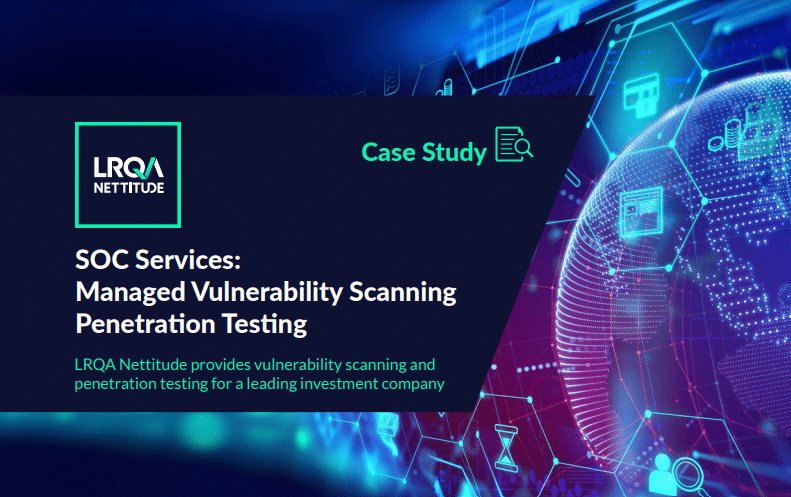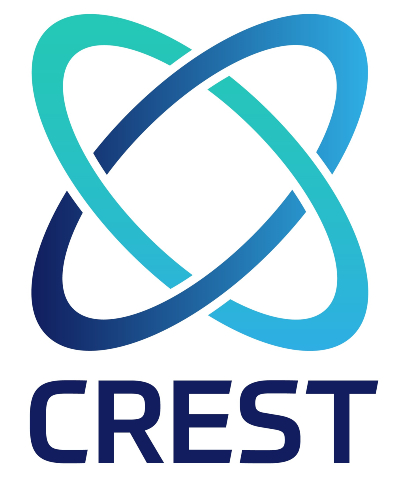Penetration testing (VAPT) services
Advanced pen testing by CREST-certified experts
A penetration test is an attempt to evaluate the security of your IT infrastructure through the safe exploitation of vulnerabilities via certified professionals. LRQA Nettitude specializes in the delivery of rigorous and strenuous security testing and provides cybersecurity consultancy across a range of disciplines.
Our award-winning(teiss awards, 2024) Vulnerability Assessment and Penetration Testing (VAPT) services give you an honest, real-world view of where and how attackers can exploit weaknesses in your infrastructure, networks, people and processes. We want you to feel good about your security, so that you can have peace of mind to get on with the business of running your business.
Our security experts
Every security expert we work with is thoroughly vetted, tested and certified. We don’t just prioritize skills; every tester has a tenacious curiosity and passion for finding and exposing vulnerabilities in order to protect and secure your business.
We think people first and for us, that means we understand getting the right people for every job is paramount. We hire professionals who have spent years training to think like the bad guys; they know what makes them tick, so they are uniquely placed to get under the skin of your security measures and find the points vulnerable to attackers.
Not only that, our penetration testers are leaders in their field, contributing to industry research conferences and driving innovation to help others defend against attackers. We consult and work with regulatory bodies and work closely with governments internationally to enact progress in security markets around the world. Our team are active members in the cybersecurity community, recognized by the media as industry consultants and published authors.
What to fix, how to fix it, and when to fix it
Our penetration testing ethos considers the difficulty of implementing change across your organization. We want to make it easy for you to fix vulnerabilities with actionable insights. All of our engagements come with a high-level management report and an in-depth technical review as standard. We don’t stop there; we also highlight preventative countermeasures and provide advice on remediation.
A long list of problems is never a solution – so we always make sure we prioritize fixes that will make the most impact and provide you with the context that you need, in a way that’s actually helpful.
Assurance is everything, that’s why we provide post-test support with our Security Support Desk to empower you to fix any findings within a timescale that works for you.
A test isn’t just a test at LRQA Nettitude, we provide:
- A high-level management report
- An in-depth technical review document
- Actionable insights prioritized by impact
- Support to fix what needs to be fixed in a timescale that works for you
- An end-of-engagement debrief via the delivering consultant
A world leader in CREST accreditations
We are proud to be one of the few global companies that is fully certified by The Council of Registered Ethical Security Testers (CREST) across all key disciplines.
Our team of consultants have achieved the highest accreditations for Penetration Testing, Red Teaming, Incident Response services and Threat Intelligence. In addition, we were also the first organization to be CREST accredited for our Security Operation Center services.

Case study – Providing SOC services to a leading financial investment company
This client had previously experienced a high number of vulnerabilities, from which LRQA Nettitude was able to help. The services implemented provided the client with a proactive and threat-led approach; informed by our offensive and threat intelligence teams to protect against the latest industry threats.
“From scoping through to conclusion, our experience with LRQA Nettitude has been excellent…”
– Client
Find out more information on this case study below…
A world leader in
CREST accreditations
We are proud to be one of the few global companies that is fully certified by The Council of Registered Ethical Security Testers (CREST) across all key disciplines.
Our team of consultants have achieved the highest accreditations for Penetration Testing, Red Teaming, Incident Response services and Threat Intelligence. In addition, we were also the first organization to be CREST accredited for our Security Operation Centre services.
LRQA Nettitude is an ISO 27001 certified organisation and conducts all external testing engagements from within a rigorously controlled environment. LRQA Nettitude’s security consultants hold Offensive Security OSCP and OSCE qualifications. All our pen testers have been fully background-checked. LRQA Nettitude is also an accredited supplier of CBEST and an approved provider of STAR testing services. Additionally, LRQA Nettitude’s 24/7 SOC is accredited to provide CREST SOC services.




LRQA Nettitude is also a proud member of the UK Government’s NCSC scheme. Our team of testers includes CHECK Team Leaders within infrastructure and web applications, as well as CHECK Team Members. In addition, our team is comprised of industry-recognized consultants and published authors that have been recognized by the media and the cybersecurity community.
Our penetration testing services
Web Application Penetration Testing Services
Web applications are one of the most common types of software in use today. Due to their complexity and ubiquity, web applications represent a unique challenge to the security posture of any organization. Modern web applications handle increasingly sensitive data, so it is important to ensure that they do not introduce significant risks to an organization.
LRQA Nettitude has a large team of CREST-certified penetration testers who specialize in web application penetration testing. The LRQA Nettitude penetration testing team is diverse and has a wealth of experience in security and software development.
LRQA Nettitude are highly capable of penetrating testing web applications, web services, APIs and more, across an extremely large range of technologies.
Cloud Penetration Testing Services
As technology progresses, cloud operations are becoming more and more popular. Even though this is a convenient solution, the ever-increasing reliance upon cloud systems means the risks and implications can be far greater.
Cloud penetration testing assesses the security of your cloud services in all environments – whether it’s Infrastructure as a Service (IaaS), Platform as a Service (PaaS), or Software as a Service (SaaS).
Mobile Penetration Testing Services
Mobile applications have become an integral part of everyday technology – however apps can increase your organization’s attack surface, putting you at risk.
During mobile app testing we assess design, data handling, network communication and authentication, amongst other areas. We look at the security of the app in the context of the device it resides on, as well as its communications to your servers and that server infrastructure.
Network Penetration Testing Services
In a network penetration test, your network infrastructure is security tested using a variety of techniques from a number of vantage points, both external and internal. We test a wide range of connected network devices including servers, laptops, storage drives, printers, network appliances, and even your web applications.
We look at how those components operate and communicate, who has access to them, and more. From this, we will be able to determine the security posture of those assets, as well as your network as a whole. We will determine where the most important vulnerabilities exist, which ones are most likely to be exploited by threat actors, and what actions should be taken to remediate these risks.
IoT Testing
Many of your connected devices could be at risk of cyber-attacks, and the risk can increase with the number of devices present, therefore there is an increased need for these devices to be tested and protected.
LRQA Nettitude works with creators of smart devices to provide assurance around the security posture of their devices. IoT penetration tests provide a valuable way to assess the security levels associated with a given connected device.
Social Engineering Services
Rather than only looking at technology, social engineering tests with people in mind. LRQA Nettitude can conduct engagements remotely, engaging your people with phishing emails or onsite, where we will perform reconnaissance and identify weaknesses in your physical security.
Both methodologies could provide a backdoor into your corporate environment for an attacker to exploit from the outside and is something LRQA Nettitude’ s consultants are frequently successful with.
Social Engineering tests are designed to help assist organizations increase their security posture and reduce the risk of attacks being successful, with emphasis on human vulnerability factors.
ASV Scanning
Red Teaming
Realistic scenarios are constructed and followed. This includes physical security testing, social engineering, 3rd party relationships, hacking, malware insertion, pivoting and human manipulation.
Each scenario has a specific stated objective, and the associated attack chain is designed to test your organization’s ability to prevent, detect and respond to cyber-attacks as they unfold.
Firewall Security Testing Services
In order to provide the most detailed, relevant and bespoke service possible, we will first ensure that we understand how your network is architected by speaking with your people, reviewing relevant documents and understanding relevant processes.
We then assess the configuration of the firewall itself; for example we will check the firmware version, user access controls, logging, etc. Finally, we’ll review the actual firewall rules that govern what traffic can traverse it.
Active Directory Testing
Most enterprise networks are managed by Windows Active Directory and store sensitive data such as PII, PCI DSS and R&D. An attack that successfully compromised Active Directory would likely have significant ramifications for any organization.
LRQA Nettitude’s team of CREST-certified internal penetration testers are able to review the configuration of Active Directory in order to identify any insecure practices or attack vectors that could be exploited by a malicious agent.
Hybrid Testing
A hybrid environment is the term used when Microsoft Azure AD is incorporated into existing on-premises Active Directory. Compromise of on-premises Active Directory could lead to the compromise of Azure AD and vice-versa.
LRQA Nettitude consultants will look to assess the configuration of both the Azure AD and Active Directory looking for misconfigurations that could be exploited by an attacker. Particular focus is placed on attack paths that could lead to the compromise of Azure AD Connect, a high-value target with high privileges both on-premises and within the cloud.
Wireless Penetration Testing
In addition, any clients that interact and utilize the wireless infrastructure, such as employees, can also be targeted as a component of the engagement. LRQA Nettitude delivers wireless device testing as a common component of many internal on-site penetration tests.
Protect your Organization with LRQA Nettitude’s
Award-Winning Cybersecurity Services
Speak to one of our cybersecurity experts now…












